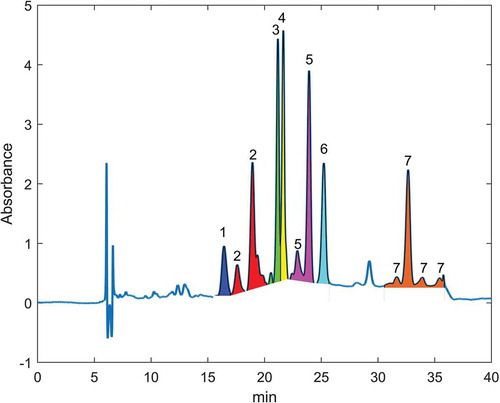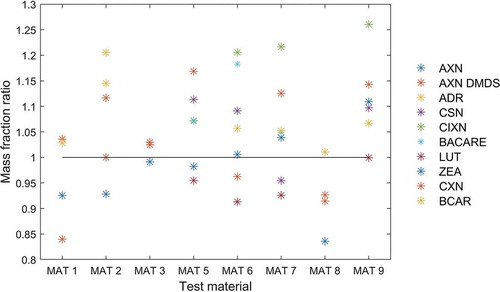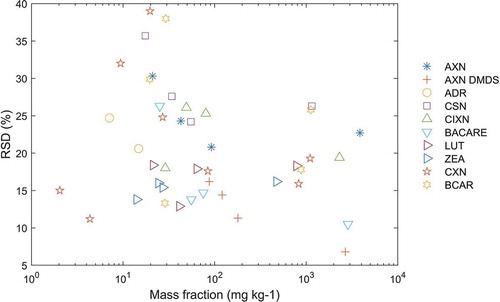Figures & data

Table 1. Composition of the nine test materials (MATs) of the study, classified in terms of the target species, i.e. fish versus poultry and type of additive, i.e. by synthesis versus natural: The target mass fractions of the carotenoids in the different test materials are shown in , and . AXN DMDS: Astaxanthin dimethyldisuccinate; BACARE: Ethyl ester of beta-apo-8ʹ-carotenoic acid. Materials used in the study: Complete feedingstuffs: For fish: MAT 1–3; For poultry: Grower feed: MAT 5, Laying hens: MAT 6 and 7. Premixtures: For fish: MAT 8, For poultry: MAT 9
Table 2. Results from the collaborative trial: Performance of the method for the determination of carotenoids exclusively used in fish feedingstuffs. AXN DMDS: Astaxanthin dimethyldisuccinate; Calculated value: Mass fraction of the carotenoids in the test material based on the certificate of analysis of the specific feed additive used; Average: Average obtained from the statistical assessment of the results from the laboratories. RSDr: relative standard deviation of repeatability; RSDR: relative standard deviation of reproducibility. No. of laboratories indicates the number of laboratories retained after removal of outliers identified by Cochran and Grubbs tests. The number in brackets is the number of laboratories identified as outliers
Table 3. Results from the collaborative trial: Performance of the method for the determination of carotenoids exclusively used in poultry feedingstuffs. BACARE: Ethyl ester of beta-apo-8ʹ-carotenoic acid; Calculated value: Mass fraction of the carotenoids in the test material based on certificate of analysis of the specific feed additive used. Average: Average obtained from the statistical assessment of the results from the laboratories. RSDr: relative standard deviation of repeatability; RSDR: relative standard deviation of reproducibility. No. of laboratories indicates the number of laboratories retained after removal of outliers identified by Cochran and Grubbs tests. The number in brackets indicates the number of laboratories identified as outliers
Table 4. Results from the collaborative trial: Performance of the method for the determination of carotenoids used in fish feedingstuffs (MAT 1-MAT 3, MAT 8) and poultry feedingstuffs (MAT 5-MAT 7, MAT 9). Calculated value: Mass fraction of the carotenoids in the test material based on certificate of analysis of the specific feed additive used, *: Average from the homogeneity study due to a strong discrepancy with the calculated value probably caused by a problem with the preparation of the test material. Average: Average obtained from the statistical assessment of the results from the laboratories. RSDr: relative standard deviation of repeatability; RSDR: relative standard deviation of reproducibility. No. of laboratories indicates the number of laboratories retained after removal of outliers identified by Cochran and Grubbs tests. The number in brackets is the number of laboratories identified as outliers
Figure 1. Two chromatograms of a solution containing exclusively the astaxanthin dimethyldisuccinate standard substance, namely the chromatograms prior to the isomerisation experiment (blue line) and after this experiment (red line). While the chromatogram of the standard prior to the experiment exclusively shows a single peak labelled “1” corresponding to the all-trans isomer, the chromatogram shows after the experiment two additional peaks labelled “2”, which are two main cis isomers

Figure 2. Chromatographic profile for some isomerised carotenoids obtained by analysis of Mat 6. The peaks of the same colour are different cis-trans isomers of the same anlayte labelled with the following numbers: (1) canthaxanthin, (2) capsanthin, (3) citranaxanthin, (4) ethyl ester of beta-apo-8ʹ-carotenoic acid, (5) lutein (6) zeaxanthin and (7) beta-carotene

Figure 3. Comparison of the results from two laboratories having applied PLE with the results of all laboratories shown by the mass fraction ratio. This parameter is obtained by dividing separately for each analyte/matrix combination the average mass fraction reported by two laboratories having applied PLE by the corresponding average value of the mass fractions of all laboratories. AXN: astaxanthin. AXN DMDS: astaxanthin dimethyldisuccinate. ADR: adonirubin. CSN: capsanthin. CIXN: citranaxanthin. BACARE: ethyl ester of beta-apo-8ʹ-carotenoic acid. LUT: lutein. ZEA: zeaxanthin. CXN: canthaxanthin. BCAR: beta-carotene

Figure 4. Precision expressed in terms of relative standard deviation for reproducibility RSD (%) of the method obtained from the 43 statistical assessments versus the mass fraction of the 10 carotenoids. AXN: astaxanthin. DMDS: astaxanthin dimethyldisuccinate. ADR: adonirubin. CSN: capsanthin. CIXN: citranaxanthin. BACARE: ethyl ester of beta-apo-8ʹ-carotenoic acid. LUT: lutein. ZEA: zeaxanthin. CXN: canthaxanthin. BCAR: beta-carotene

